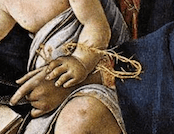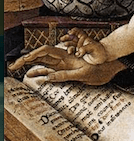A new poem…
I was shuffling down the sidewalk that night,
My hands fixed in the pockets of my coat,
Thumb and finger turning at keys, aping
The turning in my mind,
When I found myself outside Hopper’s Nighthawks.
It was eerie at first to see my curious look
In the reflection of the old diner,
Though not so old in this impossible present
Where I stood peering through the dingy glass,
Squinting to note the familiar figures at the bar:
The hatted cigaretteer, the suspicious woman in red,
Their hands eternally touching or not touching,
The amiable boy tending the bar
And the fourth with his back to the world.
I drew my forehead up to the window
To determine how cool this outside dark,
Placing my hands like parentheses around my eyes
Only to see the still figures inside
Staring at nothing,
Dwelling on absent futures, listless
In their fixed points where Phillies are only 5¢
And the lights are always on.
Yet before I pulled away to turn the corner to my car,
A lazy glance happened upon a single glass,
Idle and unclaimed,
On the nearer end of the bar,
Removed from the four characters
Paralyzed in their cold moments.
So I drifted inside,
Lay my keys and scarf upon the counter,
And asked the boy if he’d exchange the empty tumbler
For a coffee cup like the others.
But he wouldn’t take it, wouldn’t even listen,
Didn’t even stand up straight from his persistent stooping,
And I gathered the glass was meant to stay,
Left by someone else,
Destined never to be filled,
Perhaps stuck in his own still point,
Caught in a portrait of frozen dancing
Or motionless on the curb.
I scooped up my keys and turned them over,
One by one around the ring,
But not before I waited for a while
To see what would happen next.


 A few weeks ago, I had the privilege of touring the Museum of Biblical Art in Dallas and discovered a beautiful painting by Botticelli titled Madonna of the Book. In the center of this piece sits Mary with the Christ child on her lap as they both read from a medieval book of hours, a sacred devotional text common to Botticelli’s generation. Noticeably, Mary is pensive, contemplative, and even mournful in her pose as she studies the book.
A few weeks ago, I had the privilege of touring the Museum of Biblical Art in Dallas and discovered a beautiful painting by Botticelli titled Madonna of the Book. In the center of this piece sits Mary with the Christ child on her lap as they both read from a medieval book of hours, a sacred devotional text common to Botticelli’s generation. Noticeably, Mary is pensive, contemplative, and even mournful in her pose as she studies the book. He was born to die. This is the will of God that “Jesus, delivered up according to the definite plan and foreknowledge of God, [be] crucified and killed by the hands of lawless men” (Acts 2:23). Indeed, Christ came into this world to “give his life as a ransom for many” (Matt. 20:28). As Mark Lowry famously wrote in a
He was born to die. This is the will of God that “Jesus, delivered up according to the definite plan and foreknowledge of God, [be] crucified and killed by the hands of lawless men” (Acts 2:23). Indeed, Christ came into this world to “give his life as a ransom for many” (Matt. 20:28). As Mark Lowry famously wrote in a  Yet, Christ guides her hand with His. “Keep reading. Keep reading.” Notice His left hand holding hers and His right hand guiding her back to the story. We must keep reading. Christ must die on the cross so that we must not. His steady and victorious look to His mother tells us everything. “I must do this for you,” he says to her and to us. “I love you. You must keep reading.” For as we keep reading, we discover that the story does not end at His death. In the words of the Battle Hymn, “Let the hero, born of woman, crush the serpent with His heel […] His truth is marching on.” He marches on. He marches on. Glory, glory, hallelujah.
Yet, Christ guides her hand with His. “Keep reading. Keep reading.” Notice His left hand holding hers and His right hand guiding her back to the story. We must keep reading. Christ must die on the cross so that we must not. His steady and victorious look to His mother tells us everything. “I must do this for you,” he says to her and to us. “I love you. You must keep reading.” For as we keep reading, we discover that the story does not end at His death. In the words of the Battle Hymn, “Let the hero, born of woman, crush the serpent with His heel […] His truth is marching on.” He marches on. He marches on. Glory, glory, hallelujah.